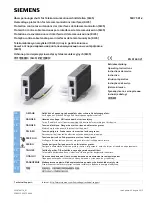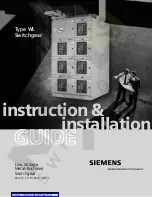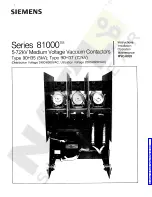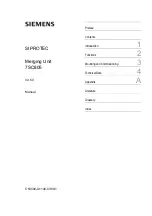
phase-earth fault and the function will eventually use phase-to-phase zone
measurements also here.
In cases where the fault current infeed is more or less completely of zero sequence
nature (all phase currents in phase), the measurement will be performed in the phase-
to-earth loops only for a phase-to-phase-earth fault.
However, should it be desirable to use phase-to-earth (and only phase-to-earth) zone
measurement for phase-to-phase-earth faults, there is a setting
INReleasePE
that can
be lowered from its excessive default value to the level above which phase-to-earth
measurement should be activated.
7.3.7.4
Directional criteria
Several criteria are employed when making the directional decision. The basis is
provided by comparing a sum of positive sequence voltage and memory voltage with
phase currents. For extra security, especially in making a very fast decision, this
method is complemented with an equivalent comparison where, instead of the phase
current, the change in phase current is used. Moreover, a basic negative sequence
directional evaluation is taken into account as a reliable reference during high load
condition. Finally, a zero sequence directional evaluation is used whenever there is
more or less exclusive zero sequence in-feed.
The directional sectors that represent forward direction, one per measuring loop, are
defined by the following equations.
−
° <
−
(
)
⋅
+
⋅
(
)
<
°
15
1
1
1
120
1
1
1
arg
k
U
k U
I
L
L M
L
EQUATION2546 V2 EN
(Equation 44)
−
° <
−
(
)
⋅
+
⋅
(
)
<
°
15
1
1
1
120
1 2
1 2
1 2
arg
k
U
k U
I
L L
L L M
L L
EQUATION2547 V2 EN
(Equation 45)
Where:
U1
L1
is the positive sequence phase voltage in phase L1.
U1
L1M
is the positive sequence memorized phase voltage in phase L1.
I
L1
is the phase current in phase L1.
U1
L1L2
is the voltage difference between phase L1 and L2 (L2 lagging L1).
U1
L1L2M
is the memorized voltage difference between phase L1 and L2 (L2 lagging L1).
I
L1L2
is the current difference between phase L1 and L2 (L2 lagging L1).
k
is the factor determining the amount of memory voltage.
The corresponding reverse directional sectors range from 165 to -60 degrees. The
value of the k factor determining the amount of memory voltage used is normally 0.8.
1MRK502052-UEN B
Section 7
Impedance protection
215
Technical manual
Summary of Contents for Relion REG670
Page 1: ...Relion 670 series Generator protection REG670 2 0 IEC Technical manual ...
Page 2: ......
Page 44: ...38 ...
Page 58: ...52 ...
Page 80: ...74 ...
Page 106: ...100 ...
Page 482: ...476 ...
Page 548: ...542 ...
Page 570: ...564 ...
Page 600: ...594 ...
Page 608: ...602 ...
Page 630: ...624 ...
Page 862: ...856 ...
Page 1094: ...1088 ...
Page 1226: ...1220 ...
Page 1250: ...1244 ...
Page 1297: ...1291 ...
















































